Small birds with long wings are amazing creatures that catch our eye with their beautiful flying. Even though they are small, their wings help them fly high and travel far distances. Whether they are gliding through the sky or quickly flying between trees, these birds are a joy to watch. Their long wings not only make them strong flyers but also give them a graceful look that bird lovers enjoy. Let’s take a closer look at some of these incredible small birds with long wings and learn about their special features.
Top 10 Small Birds With Long Wings
| # | Bird Name | Description |
|---|---|---|
| 1 | Barn Swallow | Small bird with long, pointed wings and a forked tail. |
| 2 | Common Swift | Known for its narrow wings and fast, agile flight. |
| 3 | Ruby-throated Hummingbird | Tiny bird with rapid wing beats, known for its hovering ability. |
| 4 | Tree Swallow | Small bird with glossy blue feathers and quick, graceful flight. |
| 5 | Black Swift | Features long, curved wings, and is an expert at flying high. |
| 6 | Purple Martin | Largest swallow in North America, with long wings and a forked tail. |
| 7 | Cliff Swallow | Small bird with a square tail and long, pointed wings. |
| 8 | White-throated Needletail | Fast-flying bird with long, pointed wings and a compact body. |
| 9 | Violet-green Swallow | Small, colorful bird with long wings, known for its graceful flight. |
| 10 | Wilson’s Storm-Petrel | Small seabird with long wings, often seen gliding over the ocean. |
Top 10 Small Birds With Long Wings
Small birds with long wings are marvels of nature, capable of incredible feats of flight. Their wings, though attached to small bodies, allow them to travel vast distances, perform intricate aerial maneuvers, and live in various environments. In this article, we will explore the top 10 small birds with long wings, providing detailed descriptions followed by tables summarizing their key features for easy reference.
1. Barn Swallow
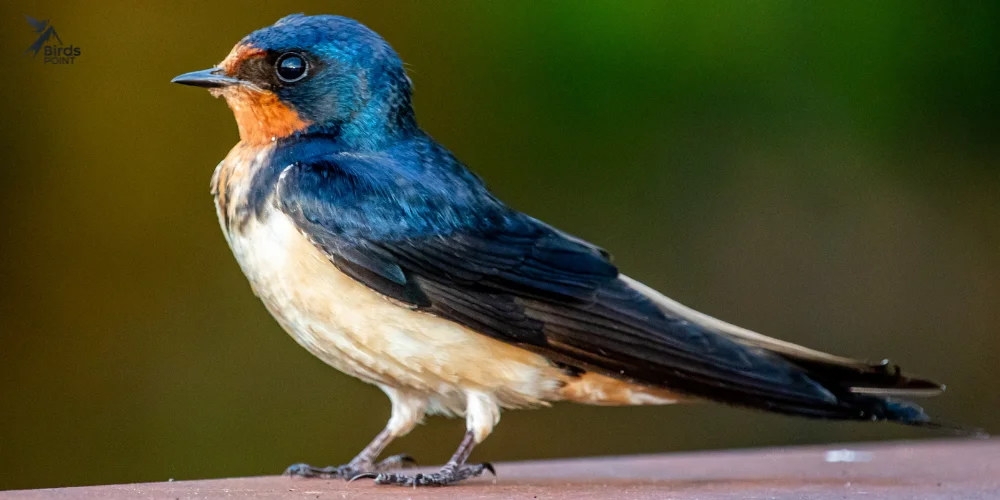
Introduction to the Barn Swallow
The Barn Swallow is a small bird that is common and easy to recognize. It has long wings and a special look. Its wingspan is between 12 and 15 inches. The top of its body is blue, and the bottom is reddish-brown. Its long, pointed wings and split tail make it easy to see when flying.
Great Flyers
Barn Swallows are amazing flyers. You can often see them flying smoothly in the sky while they hunt for insects. Their long wings help them move fast and make sharp turns to catch their food. Watching them swoop and dive is very interesting, as they fly with such grace.
Social Birds and Nest Builders
Barn Swallows like to stay together. They often build their nests in groups under bridges, on roofs, or in barns, which is how they got their name. They make their nests from mud, which makes them strong and safe for their babies. You will often see many nests close to each other because they enjoy being near other swallows.
Long Distance Travelers
One of the most special things about Barn Swallows is their long migration. Every year, they travel thousands of miles. They breed in North America and fly all the way to South America for the winter. This long journey is difficult, but Barn Swallows are strong and able to fly these great distances.
Helping Nature
Barn Swallows are not only beautiful but also helpful to nature. They eat insects, which helps farmers and gardeners by controlling pests. Seeing Barn Swallows in fields, farms, or near water is always a good sign for the environment. Their active flying adds life to the skies.
| Feature | Description |
|---|---|
| Wingspan | 12-15 inches |
| Appearance | Blue upperparts, reddish-brown underparts, forked tail |
| Diet | Insects |
| Habitat | Open fields, near water |
| Migration | North America to South America |
2. Common Swift
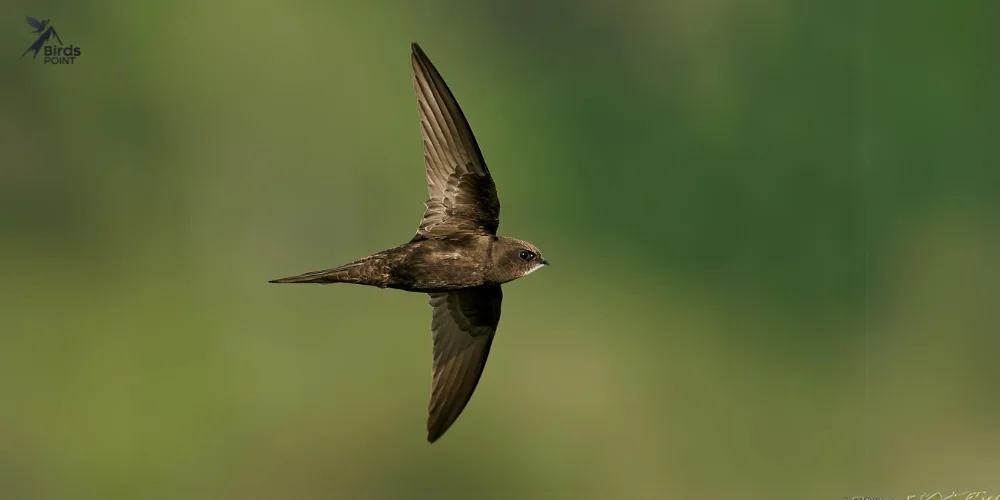
Introduction to the Common Swift
The Common Swift is a small bird that is found in many parts of the world. It is known for its fast and strong flight. The Common Swift has long, narrow wings and a small, dark body. Its wingspan is about 16 to 18 inches. The bird has a simple, dark brown color all over, which makes it blend in with the sky when flying high.
Fast and Skilled Flyers
Common Swifts are some of the fastest flying birds in the world. They spend most of their time in the air, flying quickly and smoothly. They are great at catching insects while flying. Their long, pointed wings help them move at high speeds and make sharp turns. Watching a Common Swift in flight is like watching a master at work—it is fast, precise, and full of energy.
Life in the Air
One of the most interesting things about the Common Swift is that it spends most of its life flying. Swifts can even sleep, eat, and mate while flying. They only land when they need to nest. This bird is truly built for life in the air, and it spends months flying without touching the ground.
Nesting Habits
Common Swifts build their nests in high places, like on cliffs, tall buildings, or in old houses. They use small pieces of grass and feathers to make their nests, which are stuck together with the bird’s saliva. These nests are simple but provide a safe place for their eggs and chicks. Unlike other birds, they don’t spend much time on the ground.
Long-Distance Travelers
Common Swifts are also migratory birds. They travel long distances each year. In the summer, they breed in Europe and Asia, and when winter comes, they fly all the way to Africa. These long trips show how strong and tireless these birds are. They are built to handle long flights and do it with ease.
Helping the Environment
Like many other birds, Common Swifts play an important role in the environment. They eat a lot of insects, which helps control insect populations. This is good for nature and helps farmers by reducing the number of pests that can harm crops. The presence of swifts in the sky is always a positive sign for a healthy environment.
| Feature | Description |
|---|---|
| Wingspan | 15-17 inches |
| Appearance | Sickle-shaped wings, streamlined body |
| Diet | Insects |
| Habitat | Cities, cliffs, forests |
| Migration | Europe to Africa |
3. Ruby-throated Hummingbird

Introduction to the Ruby-throated Hummingbird
The Ruby-throated Hummingbird is a small and colorful bird found mostly in North America. It is easily recognized by its bright, ruby-red throat, especially in males. The bird’s body is green on the back and white on the underside. With a wingspan of only 3 to 4 inches, it is one of the smallest birds around. Despite its tiny size, the Ruby-throated Hummingbird is known for its fast and agile flight.
Fast and Agile Flyers
Ruby-throated Hummingbirds are incredible flyers. Their wings beat very fast, about 50 to 80 times per second, which allows them to hover in one place like a helicopter. This helps them feed on nectar from flowers. They can also fly backward and upside down, which is a rare skill in the bird world. Their quick movements and ability to hover make them stand out in nature.
Feeding on Nectar
These hummingbirds mainly feed on the nectar of flowers, which provides them with the energy they need for their fast flying. They use their long, thin beaks to reach deep into flowers and drink the sweet nectar. In addition to nectar, they also eat small insects and spiders to get protein. Their feeding helps pollinate flowers, making them an important part of the ecosystem.
Nesting and Reproduction
The Ruby-throated Hummingbird builds very small nests, usually in trees or shrubs. The nests are made of plant fibers and held together with spider webs, making them soft yet strong. Female hummingbirds lay 1 to 3 eggs, which are about the size of a pea. The mother takes care of the nest and feeds the chicks until they are ready to fly.
Long Migration Journey
One of the most surprising things about Ruby-throated Hummingbirds is their long migration. Every year, they travel from North America to Central America for the winter. Some of these tiny birds even fly non-stop across the Gulf of Mexico, a journey of about 500 miles! Despite their small size, they are very strong and can make this long trip twice a year.
Importance to Nature
Ruby-throated Hummingbirds are not only beautiful but also important to nature. By feeding on nectar, they help pollinate flowers, which is essential for plant reproduction. They also help control insect populations by eating small bugs. Seeing these tiny birds flitting from flower to flower is always a joyful sight in gardens and natural areas.
| Feature | Description |
|---|---|
| Wingspan | 3-4 inches |
| Appearance | Iridescent green feathers, red throat patch (male) |
| Diet | Nectar, small insects |
| Habitat | Gardens, woodlands |
| Migration | Eastern North America to Central America |
4. Tree Swallow
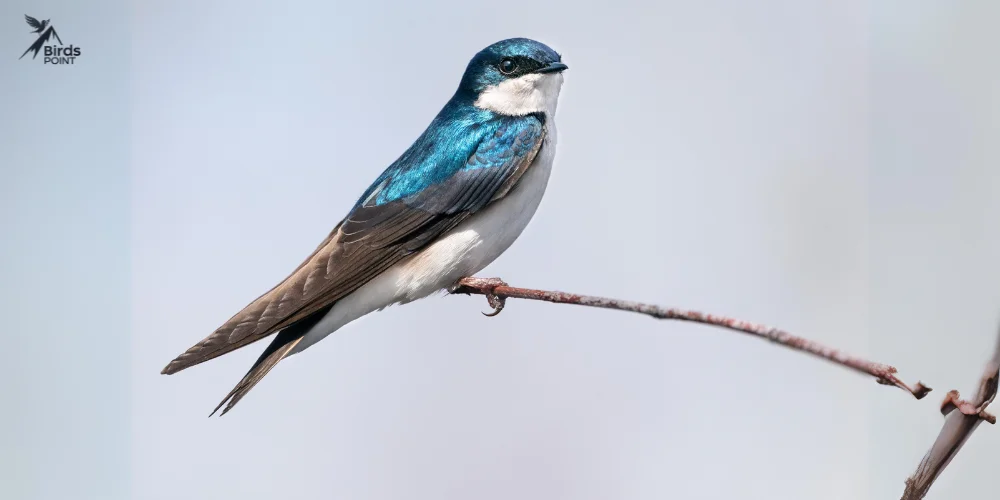
Introduction to the Tree Swallow
The Tree Swallow is a small, sleek bird commonly found in North America. It is known for its glossy blue-green feathers on its back and white belly. With a wingspan of about 12 to 14 inches, this bird is easily recognizable by its shiny, iridescent colors and smooth flight patterns. Tree Swallows are often seen near water, open fields, and wooded areas.
Skilled Flyers
Tree Swallows are excellent flyers, with graceful and quick movements. They spend a lot of time gliding and swooping through the air in search of insects, which are their main food source. Their long, pointed wings help them make quick turns, making them very agile in flight. They are often seen flying low over fields or near lakes, catching insects in mid-air.
Diet and Feeding Habits
Tree Swallows feed mostly on flying insects, such as mosquitoes, flies, and beetles. They catch their prey while flying, using their sharp reflexes and speed. During colder months, when insects are harder to find, Tree Swallows also eat berries, which helps them survive until the weather warms up again. Their diet helps keep insect populations in check, making them helpful to the environment.
Nesting in Tree Cavities
As their name suggests, Tree Swallows often nest in holes found in trees or man-made nest boxes. They build their nests using grass, feathers, and other soft materials to create a comfortable and safe space for their eggs. The female Tree Swallow usually lays 4 to 6 eggs, and both parents work together to care for their young until they are ready to fly.
Migratory Travelers
Tree Swallows are migratory birds, traveling long distances between their breeding and wintering grounds. They breed in North America during the summer and migrate to Central and South America when winter comes. Their journey is long and challenging, but Tree Swallows are strong fliers and can handle the trip with ease.
Importance to Nature
Tree Swallows play an important role in controlling insect populations, as they eat a large number of flying insects. Their presence near lakes, ponds, and fields is a good sign of a healthy ecosystem. They also benefit people by reducing the number of pest insects, making them an important part of the environment.
| Feature | Description |
|---|---|
| Wingspan | 12-14 inches |
| Appearance | Glossy blue-green feathers, white underparts |
| Diet | Insects |
| Habitat | Wetlands, open fields |
| Migration | North America to Central and South America |
5. Black Swift
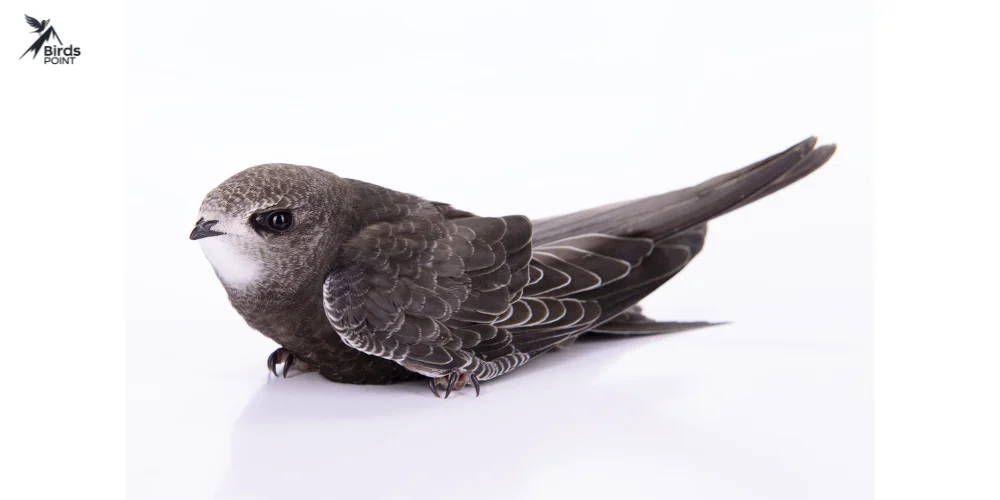
Introduction to the Black Swift
The Black Swift is a mysterious and unique bird found in parts of North and Central America. It has a dark, almost black body, which makes it difficult to spot against the sky. With a wingspan of about 18 inches, the Black Swift is larger than many other swifts, and its graceful flight is a sight to behold. This bird is often found in mountainous areas, near waterfalls, or along steep cliffs.
Strong Flyers
Black Swifts are known for their strong, powerful flight. They spend most of their lives in the air, soaring high above the ground. These birds are very fast and use their speed to catch insects while flying. They are rarely seen resting, as they are built for long, sustained flight. Their long wings and streamlined bodies allow them to glide for long periods without much effort.
Nesting in Hidden Places
One of the most fascinating things about the Black Swift is where it nests. These birds choose hard-to-reach places, such as behind waterfalls, on cliffs, or in deep caves. This provides a safe and protected environment for their eggs and young. They build their nests using moss, ferns, and other soft materials, often in locations that are damp and dark. This secretive nesting behavior makes them one of the more difficult birds to study.
Feeding Habits
The Black Swift feeds almost entirely on flying insects, catching them in mid-air during its long flights. They prefer to hunt during the day and will often fly high into the sky in search of food. Their diet includes flies, beetles, and other small insects. Since they spend so much time in the air, Black Swifts rely on their excellent flying skills to find food over wide areas.
Long Migration
Black Swifts are migratory birds, traveling great distances between their breeding grounds in North America and their wintering grounds in Central and South America. Their migration routes are not well known because of their secretive nature, but they are thought to travel over large areas of open water and mountains. Despite the challenges of their migration, these birds are strong and resilient fliers.
Importance to the Ecosystem
Although Black Swifts are not commonly seen, they play an important role in the ecosystem. By feeding on flying insects, they help control insect populations. Their presence in remote areas like mountains and waterfalls also adds to the biodiversity of those regions. Even though they are elusive, Black Swifts are a key part of the natural world, contributing to the balance of their habitats.
| Feature | Description |
|---|---|
| Wingspan | 15-18 inches |
| Appearance | Dark feathers, long, pointed wings |
| Diet | Insects |
| Habitat | High altitudes, near waterfalls, cliffs |
| Migration | North America to South America |
6. Purple Martin

Introduction to the Purple Martin
The Purple Martin is the largest member of the swallow family in North America. Known for its deep purple or bluish-black color, this bird is a favorite among birdwatchers. Males have glossy, dark feathers that shine in the sunlight, while females are lighter with grayish underparts. With a wingspan of around 15 inches, Purple Martins are easily recognized as they soar through the air. These birds are often seen near open fields, lakes, and in areas where people put up birdhouses specifically for them.
Amazing Flyers
Purple Martins are excellent flyers and spend most of their time in the air. Their long, pointed wings allow them to glide smoothly and make quick, sharp turns. They hunt for insects while flying, catching them in mid-air with their wide beaks. Their strong flying skills make them very agile and fun to watch as they swoop and dive gracefully through the sky.
Diet and Feeding Habits
Purple Martins feed mostly on flying insects, including flies, dragonflies, and beetles. They catch their food while flying, using their speed and agility. Unlike other birds, they do not often come down to the ground to look for food. Their ability to hunt in the air makes them important for controlling insect populations, which helps keep ecosystems balanced.
Nesting in Birdhouses
Purple Martins are unique because they rely heavily on man-made birdhouses for nesting. In many parts of North America, people put up special birdhouses with many compartments, which Purple Martins happily use to raise their young. In the wild, they used to nest in tree holes, but they have adapted to use these human-made homes. The female lays about 3 to 6 eggs, and both parents take care of the young until they are ready to fly.
Migratory Birds
Purple Martins are migratory birds, traveling long distances between their breeding grounds in North America and their wintering grounds in South America. Every year, they make the journey back and forth, covering thousands of miles. Their migration is a remarkable event, and many people look forward to seeing them return in the spring.
Helping the Environment
Purple Martins are not only beautiful birds but also very helpful to the environment. By eating large numbers of insects, they help reduce pests that can be harmful to crops and gardens. Many people enjoy watching them, and they are often considered a symbol of summer when they return to their birdhouses. Providing homes for Purple Martins is a great way to help these birds and enjoy their graceful presence.
| Feature | Description |
|---|---|
| Wingspan | 15-16 inches |
| Appearance | Glossy blue-black feathers, long, pointed wings |
| Diet | Insects |
| Habitat | Open areas, near water |
| Migration | North America to South America |
7. Cliff Swallow
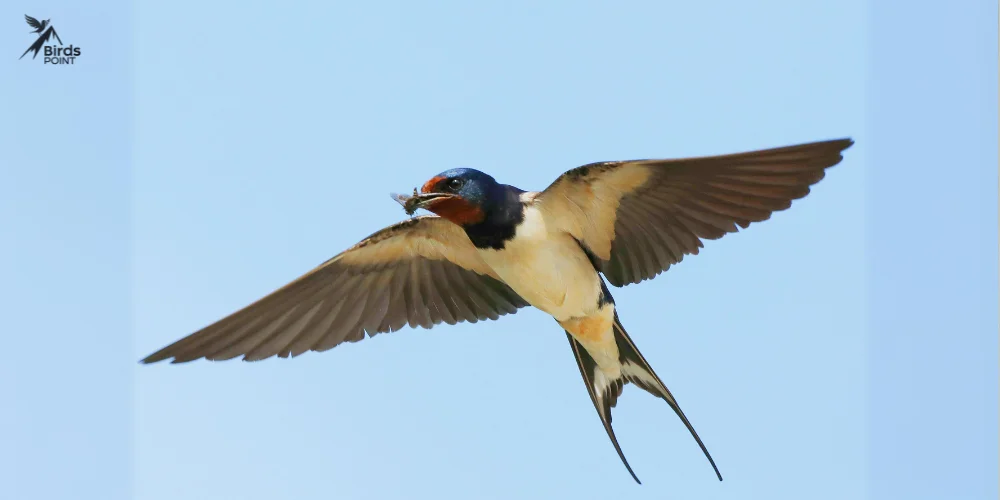
Introduction to the Cliff Swallow
The Cliff Swallow is a small, social bird that is commonly found across North America. Known for its unique mud nests and large colonies, this bird is easily recognizable by its square tail, pale orange rump, and white forehead. With a wingspan of about 11 to 13 inches, Cliff Swallows are often seen flying in large groups near open fields, lakes, and cliffs, where they build their nests.
Skilled Flyers
Cliff Swallows are excellent flyers and spend much of their time in the air. Their short, pointed wings allow them to make quick turns and swoops as they hunt for insects. Like other swallows, they catch their food while flying, using their speed and agility to grab insects mid-air. Their flight is quick and graceful, and they are often seen in large flocks, moving together in synchronized patterns.
Building Mud Nests
One of the most interesting things about Cliff Swallows is how they build their nests. They create dome-shaped nests out of mud, usually attaching them to cliffs, bridges, or the sides of buildings. These nests are sturdy and provide a safe place for the swallows to raise their young. A colony of Cliff Swallows can have hundreds of nests grouped together, making for a lively and noisy community.
Social Birds
Cliff Swallows are highly social and live in large colonies. These colonies can range from a few dozen to thousands of birds. They prefer to nest in groups because it offers protection from predators and helps them find food more easily. Living in large groups also allows them to share information about good feeding areas, making them more efficient hunters.
Diet and Feeding Habits
Cliff Swallows feed mainly on flying insects, such as flies, beetles, and mosquitoes. They hunt for their food while flying, catching insects in mid-air. They are particularly helpful to farmers and gardeners because they eat large amounts of insects that can damage crops. By feeding on pests, Cliff Swallows play an important role in controlling insect populations.
Migratory Birds
Cliff Swallows are migratory birds that travel long distances between their breeding grounds in North America and their wintering grounds in South America. Every year, they make the long journey south as the weather cools, and return north in the spring to breed. Their migration is a well-coordinated event, and they often travel in large flocks during this journey.
Importance to the Environment
Cliff Swallows are important birds for the environment because they help control insect populations. Their presence is a sign of a healthy ecosystem, and they are beneficial to both nature and agriculture. Their large colonies and impressive mud nests are also a fascinating part of their behavior, making them an interesting species to observe in the wild.
| Feature | Description |
|---|---|
| Wingspan | 11-13 inches |
| Appearance | Square tail, long, pointed wings |
| Diet | Insects |
| Habitat | Cliffs, bridges, buildings |
| Migration | North America to South America |
8. White-throated Needletail

Introduction to the White-throated Needletail
The White-throated Needletail is one of the fastest birds in the world, known for its incredible speed and sleek appearance. It is found mainly in Asia and parts of Australia. This bird has a dark, glossy body with a white throat, giving it its name. With a wingspan of about 18 inches, the White-throated Needletail is built for fast, efficient flight, and is often seen darting through the sky at amazing speeds.
Fastest Flyers
The White-throated Needletail is famous for its speed. It is believed to be one of the fastest flying birds, reaching speeds of up to 105 miles per hour. Its long, pointed wings and streamlined body help it move quickly and effortlessly through the air. This bird spends most of its time flying, and its powerful wings allow it to glide and maneuver with incredible agility.
Feeding in Flight
Like other swifts, the White-throated Needletail feeds on flying insects. It catches its food while flying, using its wide mouth to scoop up insects mid-air. It prefers to hunt in open skies, often flying at high speeds while searching for food. This bird’s feeding habits help control insect populations, making it an important part of the ecosystem.
Nesting in High Places
White-throated Needletails nest in hard-to-reach places, like high cliffs, caves, or tall trees. They build their nests using grass, feathers, and other soft materials, often tucked away in hidden crevices. Their nests are well-protected, providing a safe environment for their eggs and young chicks. These birds are highly adapted to life in remote, elevated areas where predators are few.
Long Migration Journeys
The White-throated Needletail is a migratory bird, traveling great distances between its breeding and wintering grounds. They breed in parts of Asia, such as Siberia and China, and migrate to warmer regions, like Southeast Asia and Australia, during the winter months. Their migration is a long and difficult journey, but their incredible flying ability allows them to travel these great distances with ease.
Importance to Nature
The White-throated Needletail plays an important role in maintaining a healthy ecosystem. By feeding on flying insects, it helps keep insect populations under control. These birds are also fascinating to watch due to their incredible speed and graceful flight. Their presence in the sky is a reminder of nature’s remarkable abilities, showcasing the beauty and power of flight.
| Feature | Description |
|---|---|
| Wingspan | 18-20 inches |
| Appearance | Long, pointed wings, compact body |
| Diet | Insects |
| Habitat | Forests, mountains, open areas |
| Migration | Asia to Australia |
9.Violet-green Swallow
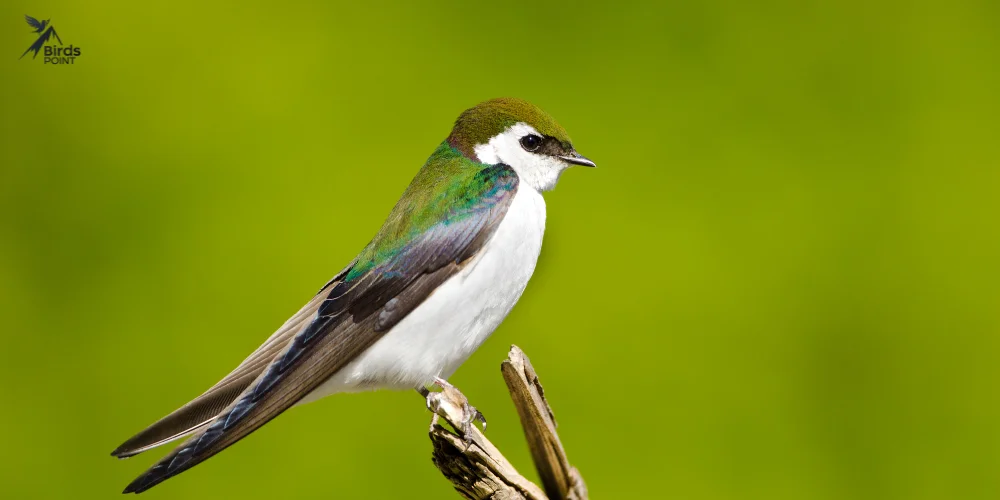
Introduction to the Violet-green Swallow
The Violet-green Swallow is a small, colorful bird found across western North America. This bird is easily recognizable by its vibrant green back, violet-colored rump, and bright white underside. Males are particularly colorful, while females have more muted tones. With a wingspan of about 11 to 13 inches, the Violet-green Swallow is a graceful flyer, often seen darting through the sky in search of food.
Skilled Flyers
Violet-green Swallows are excellent flyers, known for their swift and agile movements. They spend much of their time flying, catching insects while on the wing. Their short, pointed wings help them make quick turns and smooth glides, making them fun to watch as they zip through the air. They often fly over open fields, lakes, and forests, where they find plenty of insects to feed on.
Feeding on Insects
The Violet-green Swallow’s diet consists mainly of flying insects, such as flies, beetles, and moths. They catch these insects while flying, often hunting in groups with other swallows. Their ability to catch insects mid-flight helps control insect populations, which benefits the environment. In colder weather, when insects are scarce, they may also feed on berries to survive.
Nesting in Cavities
Violet-green Swallows prefer to nest in natural cavities, such as tree holes or cliff crevices. They are also known to use birdhouses and man-made structures for nesting. The nests are built using grass, feathers, and other soft materials to create a cozy space for their eggs. The female lays about 4 to 6 eggs, and both parents take care of the young birds until they are ready to leave the nest.
Migratory Birds
These swallows are migratory, traveling long distances between their breeding grounds in North America and their wintering grounds in Central and South America. In the spring, they return to their breeding sites and begin building nests, while in the fall, they fly south to warmer regions. Their migration is a regular and impressive journey, showing their strength and endurance as long-distance travelers.
Importance to the Ecosystem
Violet-green Swallows are important for the environment because they help control insect populations by feeding on large amounts of flying insects. Their presence near lakes, fields, and forests is a sign of a healthy ecosystem. These birds also provide joy to birdwatchers and nature lovers due to their beautiful colors and active flight patterns.
| Feature | Description |
|---|---|
| Wingspan | 10-11 inches |
| Appearance | Iridescent green back, violet rump, white underparts |
| Diet | Insects |
| Habitat | Open woodlands, meadows, near water |
| Migration | Western North America to Central America |
10.Wilson’s Storm-Petrel

Introduction to Wilson’s Storm-Petrel
Wilson’s Storm-Petrel is a small seabird that is found across the world’s oceans, making it one of the most widespread bird species. This bird is known for its dark brown or blackish plumage, with a distinctive white patch on its rump. It has a wingspan of about 15 to 16 inches and is often seen gliding over the ocean’s surface. Despite its small size, Wilson’s Storm-Petrel is an expert at navigating the open sea, even in harsh weather conditions.
Amazing Flyers Over the Ocean
Wilson’s Storm-Petrels are exceptional flyers, spending almost their entire lives at sea. They are known for their fluttering, bat-like flight, and their ability to hover just above the water’s surface while feeding. Their wings are long and narrow, helping them to stay airborne for extended periods as they search for food. Even in strong winds and storms, these birds can maintain smooth and controlled flight, making them true masters of ocean navigation.
Feeding Habits
Wilson’s Storm-Petrels feed mainly on small marine creatures such as plankton, small fish, and crustaceans. They skim the surface of the water, often hovering just above it and dipping their feet and beaks to catch their food. This feeding method is called “pattering,” and it allows them to pick up food from the ocean’s surface without fully landing. Their diet helps maintain balance in marine ecosystems by keeping small animal populations in check.
Breeding in Remote Areas
Although Wilson’s Storm-Petrels spend most of their time at sea, they come to land to breed in remote, isolated areas. They often nest on rocky islands or cliffs in the Southern Hemisphere, including parts of Antarctica and nearby islands. They build nests in burrows or crevices, where they lay one egg each breeding season. These birds are nocturnal at their breeding sites, which helps them avoid predators.
Long-Distance Migrants
Wilson’s Storm-Petrels are long-distance migrants, traveling vast distances between their breeding and feeding grounds. During the breeding season, they are found in the Southern Hemisphere, but they migrate to the Northern Hemisphere’s oceans during the non-breeding season. This migration covers thousands of miles and showcases their incredible endurance as they traverse the world’s seas.
Importance to the Marine Ecosystem
Wilson’s Storm-Petrels play an important role in marine ecosystems by feeding on small ocean creatures, which helps regulate the populations of these animals. Their widespread presence across the globe is a sign of a healthy marine environment. Although they are small and often hard to spot, Wilson’s Storm-Petrels are key players in maintaining the balance of life in the oceans.
| Feature | Description |
|---|---|
| Wingspan | 16-18 inches |
| Appearance | Dark plumage with white wing and tail markings |
| Diet | Small marine prey |
| Habitat | Southern oceans, breeding on remote islands |
| Migration | Long-distance migrator, covering vast areas |
Conclusion
These small birds with long wings are some of the most remarkable creatures in the avian world. Their long wings provide them with incredible speed, agility, and the ability to travel great distances, making them fascinating subjects for birdwatchers and nature enthusiasts alike. Whether they are swooping low over open fields, gliding high in the sky, or performing intricate aerial maneuvers, these birds showcase the beauty and wonder of flight in its most extraordinary form.
FAQs
1. What defines a small bird with long wings?
Small birds with long wings are typically characterized by their relatively small body size and elongated wing structure, which helps them achieve agility and speed in flight.
2. Why do some small birds have long wings?
Long wings help these birds with efficient flight, allowing them to travel long distances, catch insects mid-air, and perform intricate aerial maneuvers.
3. Are small birds with long wings migratory?
Many small birds with long wings are migratory, traveling significant distances between their breeding and wintering grounds.
4. Can I spot these birds in my local area?
It depends on your location. Some small birds with long wings are more common in specific regions or during certain seasons. Check local birdwatching guides for more information.
5. What do these birds typically eat?
Most small birds with long wings primarily eat insects, but some may also consume nectar or small seeds depending on their species and habitat.
6. How can I attract these birds to my yard?
Provide suitable habitats like open areas with water sources, or install birdhouses and feeders that cater to their dietary needs.
7. Are any of these birds endangered?
While some small birds with long wings are common, others may face threats due to habitat loss and climate change. Check conservation status for specific species to learn more.
2 thoughts on “Top 10 Small Birds With Long Wings: ID Guide & Photos”